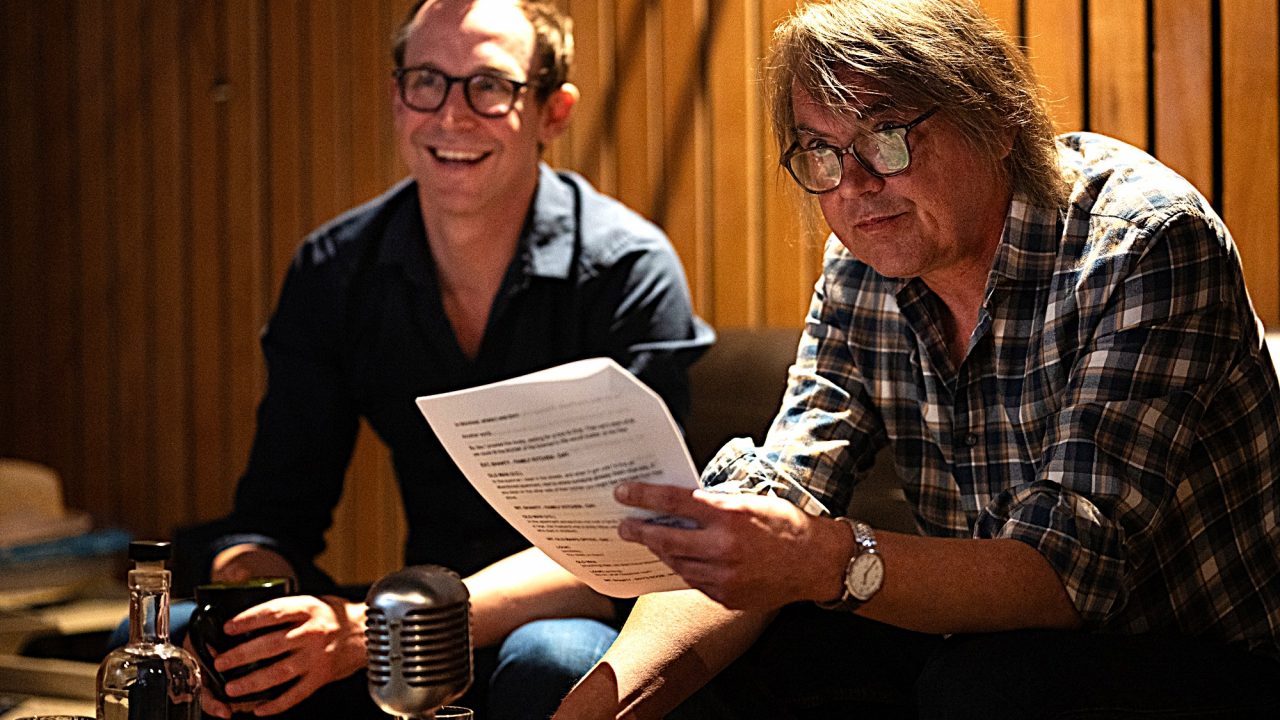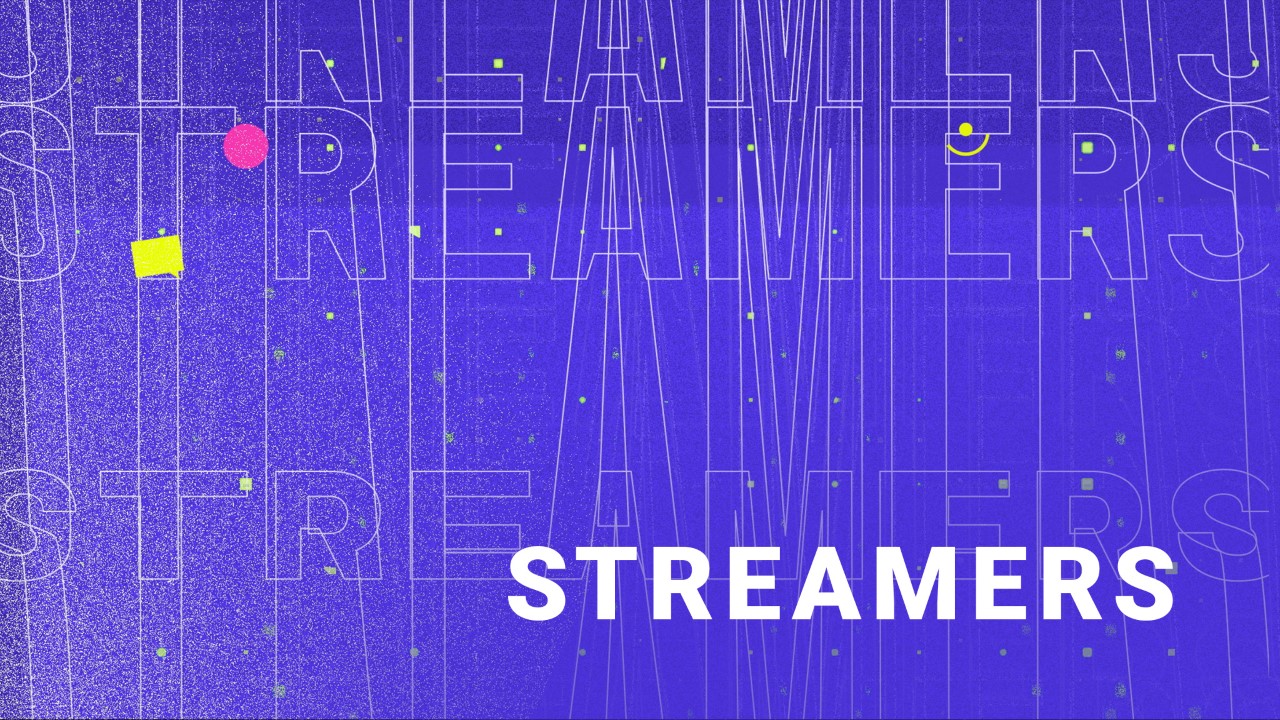
Streamers: from the idea to a web series
Streamers: from the idea to a web series
Streamers are among the most active communities on the Internet. More than two million users post content every day (essentially video games played in real time) and reach some 100 million people who connect to the platform—the most popular of its kind in the world—every month. Between Fortnite, League of Legends and Grand Theft Auto, that added up more than 9 billion hours of video streamed in 2018. Today, Twitch is the fourth biggest user of bandwidth on the planet and generates a healthy revenue for those with the most followers.
On a deeper and more fundamental level, this phenomenon has ushered in a new kind of social bond, a new way of connecting with others and a new sense of togetherness.
So, how do you document what is emerging from this ever-growing niche community? How do you bear witness to the phenomenon and present it from an author’s point of view? How do you create a web series not on the Twitch community but with it? And, if possible, in real time and connected, just like the streaming platform itself?
That’s the challenge accepted by Guillaume Braun, founder and artistic director of Akufen, the digital creative studio behind projects like Journal d’une insomnie collective, Fort McMoney and Do Not Track. He put his professional ventures more or less on hold for two years to devote himself to streamers. What follows is the story of an incredible adventure and a personal challenge. An x-ray of a web series in the making.
Immersion
When he presented his project to the NFB, Guillaume Braun met with producers on… the Akufen Twitch channel. This wasn’t a caprice on his part. The author had immersed himself in the platform for several years to get an inside look at a world he had known (he is himself a gamer) but never quite mastered. “I wanted to do a short doc on notions related to exploration, contact with insiders, user influence and the interactive experience,” he wrote in 2017. “I wanted to explore the milieu to examine the scope of the phenomenon and get to know the key players. Who are streamers? Why do they do what they do? Who are the viewers? What attracts them to this platform? I wanted to make a very human film, and tell the story of streamers, each of whom are unique in their own right.”
For its part, the NFB has long been interested in phenomena that fly under the traditional media radar. They support projects that give visibility to those that society often overlooks and who may shed light on our collective future. “Streamers has enabled us to explore a new documentary form in the uncharted territory generated by our hyper-connected era of live access,” explains Louis-Richard Tremblay. “The streaming phenomenon has given rise to a new language and new cultural practices. How do you capture this? First, you immerse yourself fully in the world to understand what makes it unique and how it evolves. And then you leverage the great documentary tradition with the technological tools of today.”
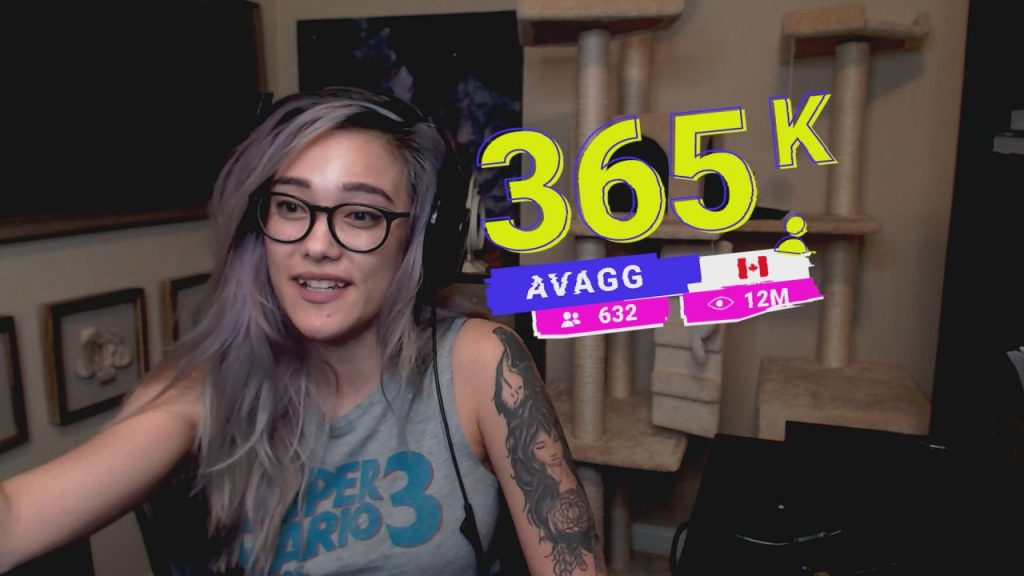
How is streaming changing our relationship with the world? According to Marianne Lévy-Leblond, that’s also what motivates the teams at ARTE France. “We’ve been involved in the Streamers project since the beginning. It has given us the chance to meet communities whose rising importance is not well understood. In fact, that’s become a central concern of our public service missions, in that it provides a window into communities that often fall victim to false stereotypes. Gaming and streaming have become mass consumer activities. They feed popular culture and upset old hierarchies of knowledge and the patterns that define social relationships. We also believe that an “open” documentary that leverages the tools of the community that it’s observing (both for research and broadcasting purposes) is both relevant and original.”
“We’ve been involved in the Streamers project since the beginning. It has given us the chance to meet communities whose rising importance is not well understood.” – Marianne Lévy-Leblond, ARTE France
Participant observation
The creator’s initial hypothesis: Twitch is a primary manifestation of a foundation that foreshadows a new way of living (together) online. The first difficulty: as with any social platform, it comes with its own language, codes and uses that can be disconcerting to the uninitiated. Understanding and adopting them is key.
Learning the rules of the game takes time. Like a filmmaker in unknown lands—a bit like Jean Rouch—Guillaume Braun decides to embrace what ethnologists call a “participant observation” approach. He seeks to understand the Other by sharing in communal experiences, adopting the vocabulary, and breaking with old habits by literally cutting himself off from the world.
That means living on the platform and becoming the subject in order to understand the world from within rather than describe from the outside. Interviewing someone isn’t the same as putting yourself in their shoes. Guillaume Braun wanted to gain an intimate understanding of what drives streamers. “We decided to do a documentary that would be designed, watched and accepted by the subjects,” he says. Which was also a clever way to establish trust, gain credibility and create authentic connections with his future characters. An ambitious project, as one can quickly fall out of favour in the Twitch world. You have to proceed with caution or risk jeopardizing your likeability—and your membership into the community.
“We decided to do a documentary that would be designed, watched and accepted by the subjects.” – Guillaume Braun
Avatar

Diving headlong into the experience, Guillaume Braun becomes Will. Under cover of this avatar, he sets out to become part of the fold. He roams around the platform, fascinated by a world of superstar streamers with millions of followers and streamers with no followers at all. He takes part in chats, comments and does live streams of his own, and watches hours upon hours of video every day until he earns the trust of a renowned streamer who lets him moderate his account.
Beyond a simple avatar or an “improved version of himself”, he creates a whole world with its own tone and aesthetic as well as a unique way of engaging with others on the streets and back alleys of Twitch. This practical approach mirrors his intellectual one of avoiding sensationalism to better understand “the most misunderstood pop culture of the modern era.”
The undertaking requires self-sacrifice and humility. You can’t stream part time if you want to reach audiences, and Will began in an empty chat room. His avatar could have leveraged communities that were already well established (like Akufen’s, for instance) but he refused, opting to put himself in the shoes of a true novice.
Until he became one of them.
Duo
Twitch is both a communal and a solitary experience. It’s personal and personalized. It revolves around the self and is also deeply social. Will didn’t have all of the resources at hand to stand out in such a niche society, so he formed a team to help him carry out his project. The NFB producers recommended joining forces with Marie-Ève Tremblay, a CBC radio host known for her show, Corde sensible.
An expert in community management and live video production (where you film and interact with viewers at the same time), she is accustomed to coming face-to-face with worlds that she doesn’t understand. And, as someone whose interest in video games and streamers is minimal, she brings a critical distance to the whole endeavour.
She is deemed to be the ideal candidate to assist Guillaume in his investigation. The pair will come to form a bond when they attend the first TwitchCon in history.
Discussion
Their investigation will lead the directing duo to San Francisco in 2015 and San Diego in 2016 to attend the Twitch world equivalent of high mass. This is their chance to be in physical contact with streamers and viewers alike. The gap that separates the virtual channels from the real world is so profound that being on site is a crucial way to makes ties with the future protagonists of the project.
This is their chance to be in physical contact with streamers and viewers alike. The gap that separates the virtual channels from the real world is so profound that being on site is a crucial way to makes ties with the future protagonists of the project.
The documentary practice comes alive when they’re immersed in the reality of TwitchCon and witness the scope of the phenomenon firsthand. They see how popular and revered the streamers are… and how difficult they are to pin down for a meeting.
They want to find quality streamers who live the day-to-day reality on the platform and avoid sensationalism at all costs. Marie-Ève gets creative and invites MANvsGAME, MrMoon and Summt1g to attend a “salon” where she and Guillaume get to know the players who will become indispensable to the project, like djWHEAT, the Twitch studio director who organizes this large-scale event and who has been streaming since the era of Justin.tv in 2005.
In both San Francisco and San Diego, the directing duo is welcomed with open arms. Everyone accepts their invitations and they make solid connections. They don’t start filming yet, but the structure of the project takes shape based on their discussions with the key stakeholders. What makes their pitch so persuasive is that, as Twitch ethnologists, they aren’t interested in adopting a scientific approach where they dissect the secrets of these “strange” Twitch creatures with a magnifying glass. They treat everyone as their equals. And Guillaume introduces himself as Will—his avatar.
Everyone hits it off.
Interactivity
Back on the platform, Guillaume Braun and the Akufen team develop several tools to deepen their knowledge of streamers. They design technical devices to get the conversation going—all of which gives Will the chance to build the trust and appreciation of the community.
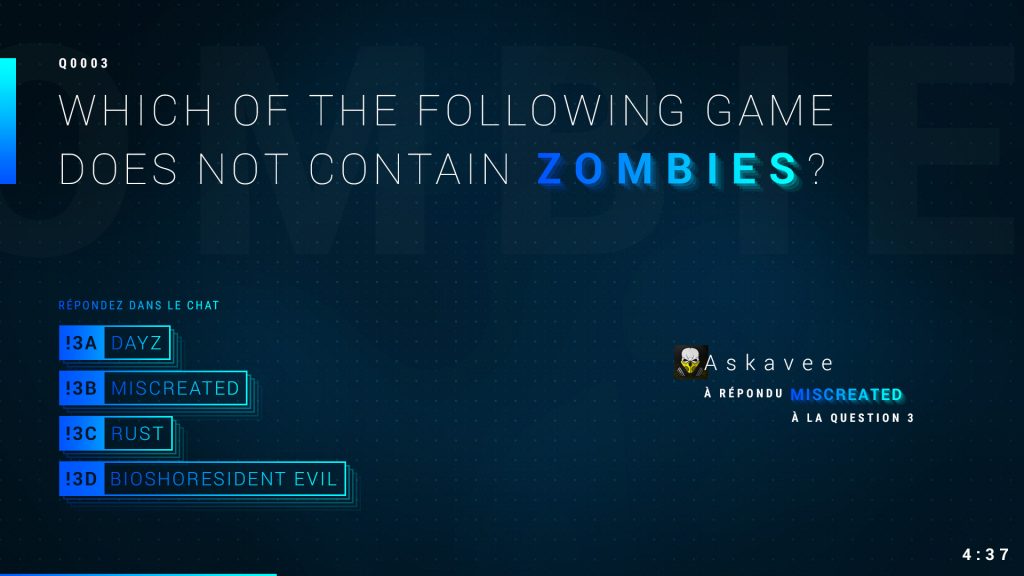
First, a mini robot chats with streamers via five interactive questionnaires, generating almost 200 hours of material. “What was the first Nintendo product?”, “On average, how much time do you spend on Twitch every week?”, “In what year was the first edition of Final Fantasy launched?” The brilliance of the device (which categorizes participants based on their answers) is that it combines questions based on their knowledge of video games with more personal inquiries. These thousands of interactions—both trivial and serious— enrich the team’s knowledge of the platform, keep the conversation going, and attract visitors, albeit a modest number.
The questionnaire was designed to create a surprise factor and keep up a conversational pace, but it lacked the human element and interactivity that is at the heart of Twitch. If Guillaume Braun had shown his face, he would no doubt have attracted more viewers, but that didn’t figure into his game plan.
If Guillaume Braun had shown his face, he would no doubt have attracted more viewers, but that didn’t figure into his game plan.
It’s worth noting that their method for reaching out to the key stakeholders of the project was directly inspired by Journal d’une insomnie collective, an interactive documentary that Akufen took part in, where insomniacs were asked questions every night, and their responses helped finetune the project (similar to the work of Katerina Cizek with her film Highrise). The submitted answers were sprinkled throughout the experience, informed the documentary process and anchored the final form of the project.
Which may indicate that there’s a connection between streaming and insomnia… 😉
Live
For this project, Guillaume Braun and Akufen also developed a technology allowing them to create “research episodes” on Twitch, which brought together several streamers to discuss the habits and customs of the platform users. They leveraged this multi-user video stream system to host live interviews on the Twitch channel many times. In total, twenty-some people took part in the debates on themes defined in advance. These “performances” were also broadcast on social media to get maximum reach.
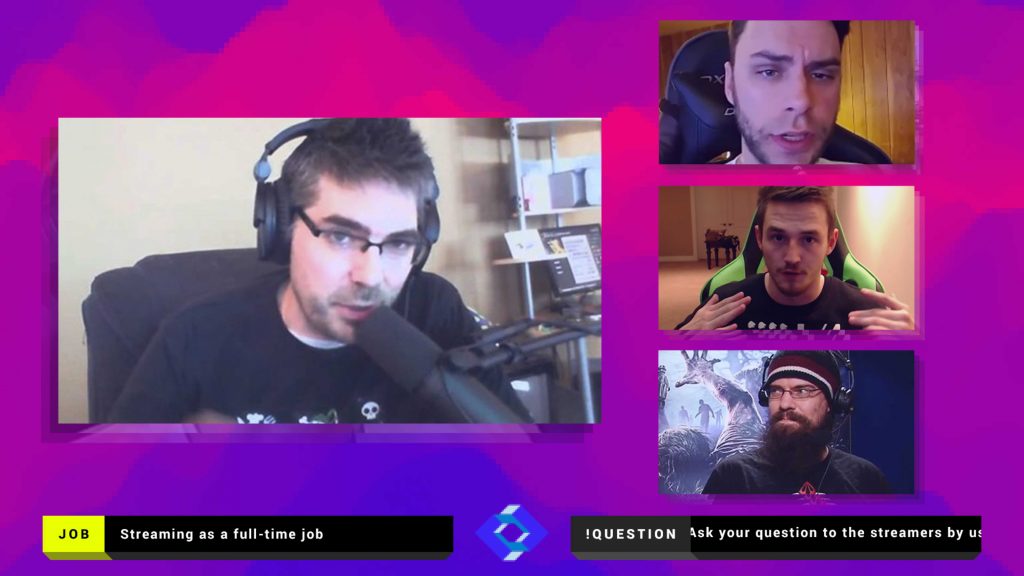
For the first time, Will spoke on behalf of the project and led the discussions. Some of the people who appeared in the final web series are featured here discussing their relationship with the platform, how it differs from YouTube, the best ways to gain exposure, what it means to be a woman on Twitch, and other ways that streaming can impact their personal lives.
This phase was a decisive one. By creating tools that encouraged streamers to take ownership of the project, and by using their answers to inform how the project took shape, Guillaume Braun stuck to his basic principle: that Twitch users who work on the platform every day are in the best position to tell their own stories.
At this stage, the directing duo collected precious information, including secrets to success and pitfalls to avoid to keep the community on your side. They met the men and woman behind the streamers and discovered their strengths and weaknesses. These discussions with their future characters will have a big impact on their editorial approach. The project’s central themes and questions will emerge directly from the debates that were broadcast in real time as part of this collective experience. The event highlights, still available on YouTube, give an interesting peek into their documentary process.
Production
Twitch was used to design the web series, so why not produce and broadcast it there too? To that end, Guillaume Braun designed an application programming interface (API), which enabled him to use Twitch just like Skype. This meant that all of the interviews could be done with and by streamers on their own terrain.
One of the platform’s characteristics is how it gives users the feeling that they’re in the same room with the person that they’re watching. This sensation of intimacy and physical proximity is echoed in how the interviews are filmed and reproduced. “We need to let streamers use the tools that they’re most familiar with if we want to get a true portrait of these public personalities that gravitate around the vast and majestic virtual world.”
“We need to let streamers use the tools that they’re most familiar with if we want to get a true portrait of these public personalities that gravitate around the vast and majestic virtual world.” – Guillaume Braun
The only cameras used for the interviews and the whole web series are those of the streamers. They are in control of the framework of their self-expression. This enables everyone to maintain their signature style to a varying degree and preserves the confidentiality of their home recording. No professional cameras, no production crews, no intimidating aspects to the recording process, which uses the platform’s own codes and language to its advantage. The participants forget about the camera and feel like they’re on in a phone call rather than a film shoot. Everything happens in the here and now with the authenticity of a live stream.
In the end, fourteen streamers (of the 36 interviewed) are cast for the web series. Their words provide the raw material for the project and their interviews provide the linear arc for the series.
From and interactive approach to linear storytelling
Streamers became a web series for lack of a sufficiently convincing interactive approach. The team considered creating an interactive site where people could connect to Twitch in real time, but technical and behavioural considerations prevented that from happening. If you send a user to an identified streamer that doesn’t happen to be broadcasting at the time, the experience is sure to be a disappointing one.
As with Journal d’une insomnie collective, only the preparation and conceptual phases of Streamers were collaborative. The interactive approach taken at the outset had an impact on the end result, but the end result was not itself interactive. At first sight, at least. As we’ll see, broadcasting four 12-minute webisodes may end up being the most interactive project that Guillaume Braun has even done.
But another challenge awaits. It’s easy to change codes with an interactive project where the production process is malleable and iterative, but in a linear process, you have to make decisions and choices that will have a lasting impact on the final form. In other words, you can’t go with a trial-and-error research approach right up to the end. You need to put validation stages in place. And once a decision is approved, you can’t go back on it.
The script
The story of Will’s adventures in the world of Twitch would no doubt have been as interesting to document as letting streamers tell their own stories. But Guillaume Braun didn’t want to put himself in the spotlight. And even if there was talk of he and Marie-Ève Tremblay telling the story, the directors preferred to use their experiences and expertise to fade into the background and give the protagonists full reign.
This desire for discretion doesn’t mean that Will is absent from the series. He does the voiceover that guides us through each episode. And though his avatar isn’t displayed on screen, Will’s aesthetic choices are all over the film: the motion design is part of his character and competes to give shape to the singular world of Streamers.
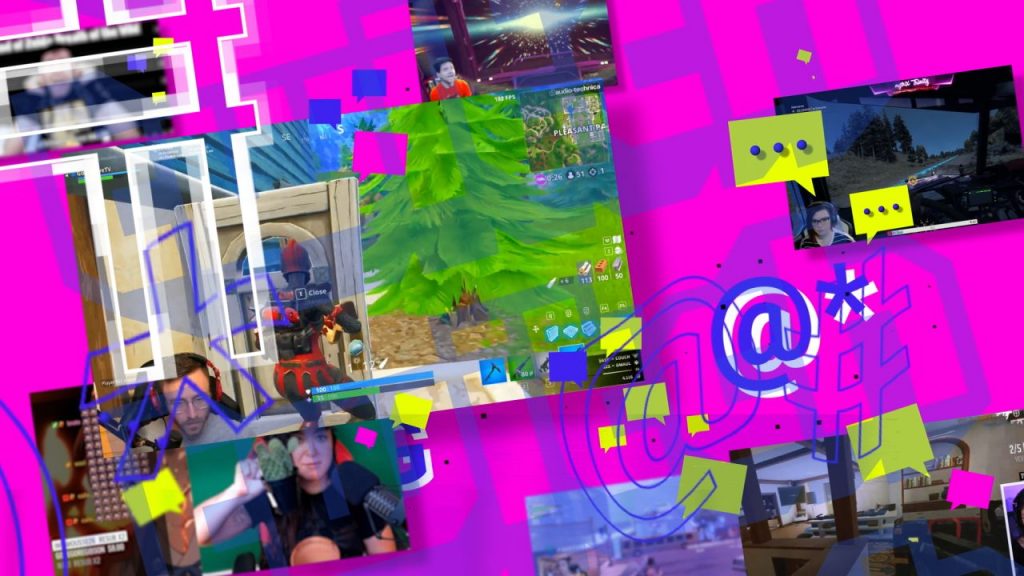
In the editing suite, the team opts for simplicity. Aside from the motion design and voiceover elements, the series consists of the interviews, a few archived streams and some visual cues (emotes, emojis and other visual references to the Twitch world) that spice up the four webisodes. It’s all about creating a little breathing room and opting for a structure that breaks up what could otherwise be an overly didactic sequence of interviews.
The narrative structure was designed to lead viewers not to a goal, but to a more profound exploration of the platform with every minute that passes. The chapters in place at the outset evolve and, at the end, four remain: “Build your community”, “Speak the lingo”, “Grind it out” and “Find your balance”. The four episodes discuss community engagement, the language and codes of Twitch, the monetisation of streaming and how to find balance between your online and offline life.
Deciding how to parse out the themes and issues was a key concern: how do you build a progression that doesn’t dissuade veteran and novice streamers alike from coming along for the ride? How do you hook both the general public and an extremely niche audience in the opening minutes of the first episode? It’s a challenging endeavour, especially when you opt for a fragmented format where you can’t control the viewing order of each episode.
How do you build a progression that doesn’t dissuade veteran and novice streamers alike from coming along for the ride? How do you hook both the general public and an extremely niche audience in the opening minutes of the first episode?
Finally, the edit was crafted to make it look like all of the discussions took place on live Twitch channel screens, with all of the inherent “real time” tension (and without making the Will character overly fictionalized). The music and soundtrack composed by Louis-Philippe Quesnel provided the finishing touch.
The “fifteenth character” of the web series, the score was designed to merge with the Twitch world. The audio track, present throughout, is not just a backdrop. It informs the world that we’re entering into little by little. There are no percussive elements. Only synthesizers that give a retro-modern effect and create an evocative soundscape as we immerse ourselves into the platform.
The last stretch
So, how do you broadcast episodes like these to get the most reach? This question—a vital one—also played a role in how Streamers was structured. Guillaume Braun had already noted in his early ideation documents: “How we broadcast the story and the ecosystem will inform how the story is told.”
As with any digital project, the goal is to reach the largest audience possible. Because of this, the authors steered clear of other interactive forms (VR included) which are harder to promote to the general public. That’s also why they didn’t go with a dedicated site and instead concentrated on platforms and social media. It was all about effectiveness of the impact vs. formal exuberance.
It made sense to consider broadcasting on Twitch itself. After all, of the 14 protagonists featured in the series, GoldGlove has 1.38 million followers, CohhCarnage has 1.06 million, and MANvsGAME has over 500,000. Will also ends up using Twitch to promote Streamers, by way of a Q&A on the GCPodcast that broadcasts the series.
And that’s how the web series became… interactive. As Guillaume himself states, the team had gone back and forth on doing an interactive format from the start. In the end, Twitch became the Streamers screening room, and the post-viewing debates were instructive and lively.
In the end, Twitch became the Streamers screening room, and the post-viewing debates were instructive and lively.
The interactivity that had been a consideration throughout became more of a state of mind for the project. In the end, rather than a click or a like, it was the community response and the reactions triggered that gave the series its interactive bent.
Other social media platforms were also enlisted to broadcast the web series. YouTube and Facebook were hard to avoid: their high traffic had to be taken into consideration, even though the attention span of users there is sometimes quite low (only a few seconds according to the most pessimistic studies).
The co-producers, NFB and ARTE, also broadcast the series on their websites, and the rollout of the program made all four episodes available everywhere at all times (much like how streamers themselves are active on Twitch, but also on Instagram, Twitter, YouTube, etc.).
Initially, the team intended to roll out the series in specific formats (i.e., vertical formats for Snapchat), but that ambition fell by the wayside in the interest of clarity. That said, the team stuck with their decision to make all episodes available at once so that users can view them in any order and not be disappointed if they come upon one by chance.
With its fragmented form and connected broadcast, Streamers relied on a significant asset: its shareability. That’s one of the advantages (always up for discussion, of course) of a web series vs. other more complex interactive forms: how quickly and easily people can recommend it to others. Guillaume Braun recognizes that, claiming that hundreds of people talked to him directly about Streamers online, whereas very few professionals spontaneously shared their experience of the film with him. Usually, it’s the other way around.
Stream spirit, are you there?
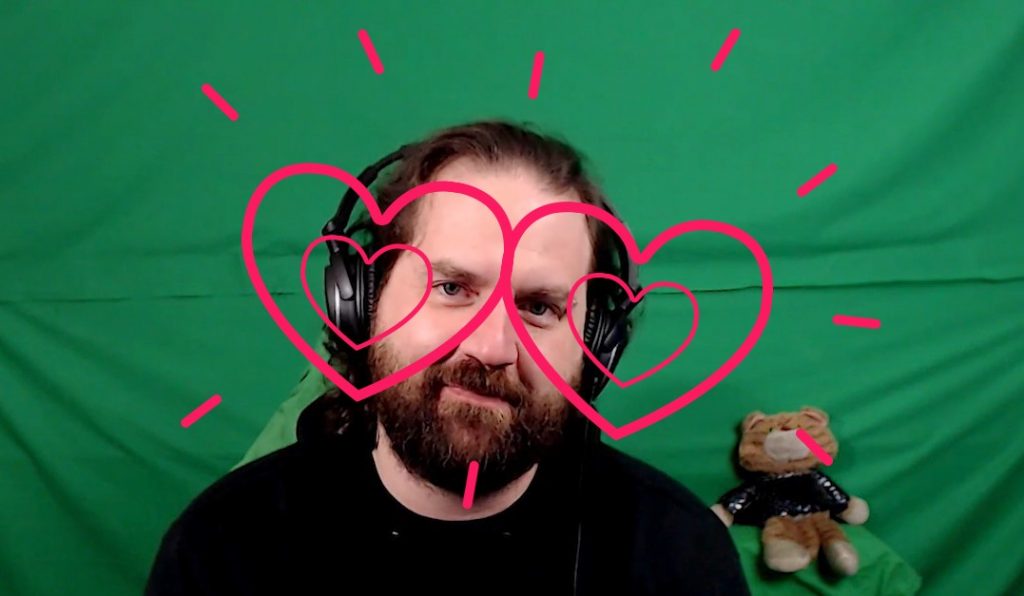
In its form, content and tone, Streamers looks a lot like a stream, which was no easy feat. Beyond that, the web series is a reflection on the hyper-connected modern world. It poses an interesting question: in the end, are video games just a pretext to get together and talk? Gaming as a shared passion where people inspire each other to build separate online identities (that are indistinguishable from their offline ones)… Twitch may, in fact, serve as both a mini society and a schoolyard where experimentation of all kinds is encouraged: a niche phenomenon that has become a mass movement.
The stories that emerge on this platform aren’t really about the streamers themselves, but about the relationships that they have with their viewers. The same is true of this web series: even if they don’t talk directly to one another, the interactions between Will and the streamers are peppered throughout, and the conversation between the series itself and the viewing public is what makes it a success.
But back to the initial challenge: documenting a niche society that is connected 24/7. Here, the creative process took place in real time, but the production and broadcasting forms couldn’t follow suit. That proved disappointing for its creators, but, even so, Streamers gives us a lot to think about when it comes to the future of digital filmmaking. It may have even paved the way to a form of interactive television in its simplest and most spontaneous form.
Streamers gives us a lot to think about when it comes to the future of digital filmmaking. It may have even paved the way to a form of interactive television in its simplest and most spontaneous form.
Streamers demonstrates that streaming has become mainstream, which lead Guillaume Braun to quote Andy Warhol’s famously prophetic words from 1968: “In the future, everyone will be world-famous for 15 minutes.” And then, laughing, he adds, “per day!”
It’s hard to tell if he’s joking or not.
If you wish to watch or rewatch Streamers, click here.
Written by Cédric Mal (Le Blog documentaire) in collaboration with the Interactive studio of the National Film Board of Canada
